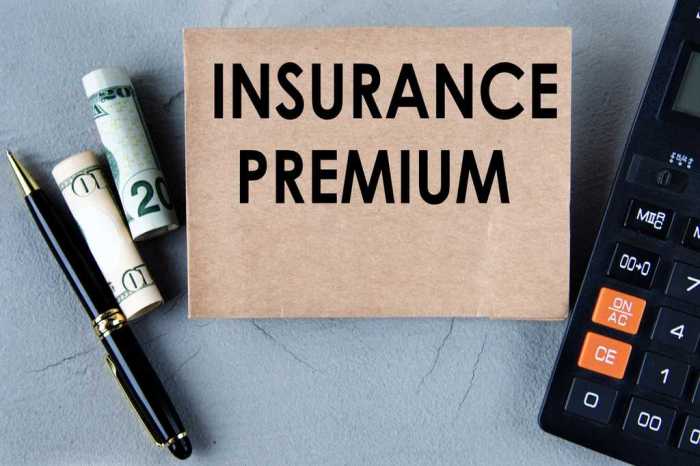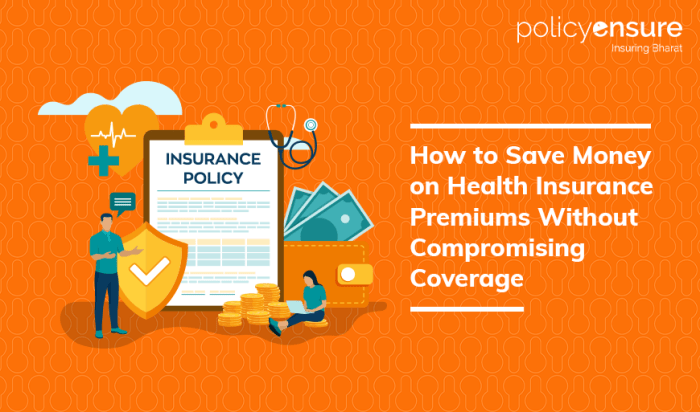When it comes to saving money on insurance premiums without compromising coverage, there are various strategies that can make a significant impact on your financial well-being. From understanding your insurance needs to exploring different providers and discounts, this topic delves into practical ways to optimize your insurance expenses.
Let's dive in and uncover the secrets to achieving cost-effective insurance solutions.
Understand Your Insurance Needs
When it comes to saving money on insurance premiums without losing coverage, the first step is to understand your insurance needs. By defining the types of coverage you require, assessing the value of your assets that need protection, and evaluating potential risks you want to mitigate, you can make informed decisions that will help you tailor your insurance policy to meet your specific needs.
Define the Types of Coverage You Require
- Start by determining the basic types of insurance coverage you need, such as auto, home, health, life, or disability insurance.
- Consider any additional coverage options, such as umbrella insurance, that may provide extra protection based on your individual circumstances.
- Review your current policies to identify any gaps in coverage or areas where you may be over-insured.
Assess the Value of Your Assets that Need Protection
- Take inventory of your assets, including your home, vehicles, personal belongings, and valuable possessions.
- Calculate the replacement cost of these assets to determine the appropriate coverage limits needed to protect them adequately.
- Consider factors such as depreciation, market value, and potential liabilities when assessing the value of your assets.
Evaluate Potential Risks You Want to Mitigate
- Identify potential risks that could impact your financial stability, such as accidents, natural disasters, or health emergencies.
- Assess the likelihood and severity of these risks to determine the level of coverage needed to mitigate them effectively.
- Consult with insurance professionals or financial advisors to help you understand the potential risks and develop a comprehensive insurance strategy.
Compare Insurance Providers
When looking to save money on insurance premiums without losing coverage, comparing insurance providers is crucial. By researching different companies, analyzing coverage options, and comparing premiums, deductibles, and discounts, you can make an informed decision that meets your needs and budget.
Research Different Insurance Companies
When comparing insurance providers, it's essential to research different companies to get a clear understanding of the options available. Look into the reputation of each company, their financial stability, and customer reviews to ensure you choose a reliable provider.
Analyze Coverage Options
Once you have narrowed down your list of potential insurance providers, analyze the coverage options each company offers. Consider the types of coverage available, such as liability, comprehensive, and collision, and determine which options are essential for your specific needs.
Compare Premiums, Deductibles, and Discounts
Compare the premiums, deductibles, and discounts offered by each insurance provider to find the best value for your money. Look for discounts for safe driving, bundling policies, or being a loyal customer to maximize your savings without compromising on coverage.
Improve Your Credit Score

Improving your credit score can have a significant impact on lowering your insurance premiums. Insurance companies often use credit-based insurance scores to assess risk, with lower scores indicating higher risk and higher premiums. Here are some tips to boost your credit score and reduce your insurance costs.
Tips to Boost Your Credit Score
- Pay your bills on time: Late payments can negatively impact your credit score, so be sure to pay your bills by the due date.
- Reduce your credit card balances: Aim to keep your credit card balances low compared to your credit limits to improve your credit utilization ratio.
- Avoid opening multiple new accounts: Opening several new credit accounts in a short period can lower your average account age and negatively affect your score.
- Monitor your credit report: Regularly check your credit report for errors and dispute any inaccuracies to ensure an accurate reflection of your creditworthiness.
- Use credit responsibly: Only apply for credit when needed and manage your existing credit accounts responsibly to maintain a healthy credit score.
Impact of Credit Score on Insurance Rates
Having a good credit score can result in lower insurance premiums, as it is often associated with lower risk and responsible financial behavior. On the other hand, a poor credit score can lead to higher insurance rates, as it may indicate a higher likelihood of filing claims.
By improving your credit score through responsible financial habits, you can potentially save money on your insurance premiums while maintaining adequate coverage.
Bundle Insurance Policies
When it comes to saving money on insurance premiums without sacrificing coverage, bundling your insurance policies can be a smart strategy. Bundling typically involves combining multiple insurance policies, such as home and auto insurance, with the same provider. This can often lead to discounts and cost savings for policyholders.
Benefits of Bundling Home and Auto Insurance
Bundling your home and auto insurance policies with the same insurance provider can offer several benefits. Not only does it simplify the insurance process by dealing with only one company for multiple policies, but it can also lead to significant cost savings.
Insurance companies often provide discounts to customers who bundle their policies, making it a cost-effective option for many.
Other Types of Insurance that Can be Bundled
In addition to home and auto insurance, there are other types of insurance policies that can be bundled to save money. Some common examples include bundling renters insurance with auto insurance, or combining life insurance with homeowners insurance. By bundling multiple policies together, you may be eligible for additional discounts and savings.
How Bundling Can Lead to Premium Discounts
Insurance providers often offer discounts to customers who bundle multiple policies with them. This is because it can lead to increased customer loyalty and retention, as well as reduced administrative costs for the insurance company. By bundling your insurance policies, you may be able to access discounted rates that would not be available if you purchased each policy separately.
This can result in overall savings on your insurance premiums while still maintaining the coverage you need.
Increase Deductibles

Raising your deductibles is a common strategy to lower insurance premiums. By opting for higher deductibles, you are agreeing to pay more out of pocket in the event of a claim, which reduces the risk for the insurance company and, in turn, lowers your premiums.When considering increasing your deductibles, it's important to understand the trade-offs involved.
While higher deductibles can lead to significant savings on your premiums, you need to ensure that you have enough funds set aside to cover the deductible amount in case of a claim. It's crucial to strike a balance between saving on premiums and being able to afford the deductible when needed.
Examples of Deductible Options and Cost Savings
- Standard Deductible: A common deductible option is $500 for auto insurance. If you raise it to $1,000, you can potentially save up to 20% on your premiums.
- Health Insurance Deductible: For health insurance, increasing your deductible from $1,000 to $2,500 could result in a 25% reduction in premiums.
- Home Insurance Deductible: Home insurance deductibles typically range from $500 to $2,500. Choosing a higher deductible of $2,000 can lead to lower annual premiums.
Maintain a Good Driving Record
Maintaining a good driving record is crucial when it comes to reducing insurance costs. Insurance providers often offer lower premiums to drivers with clean records as they are considered less risky to insure.A clean driving record typically means that you have not been involved in accidents or received any traffic violations.
This demonstrates to insurance companies that you are a responsible driver who is less likely to make claims, which can lead to lower insurance premiums.
Impact of Traffic Violations on Premiums
Receiving traffic violations such as speeding tickets, reckless driving citations, or DUIs can have a significant impact on insurance premiums. Insurance providers view these violations as indicators of risky behavior, which increases the likelihood of future claims. As a result, drivers with traffic violations on their record are often charged higher premiums to offset this increased risk.To avoid higher insurance costs, it is important to follow traffic laws, drive safely, and adhere to speed limits.
By maintaining a good driving record, you can demonstrate your responsibility as a driver and potentially qualify for lower insurance rates.
Tips for Maintaining a Good Driving Record
- Obey traffic laws: Always follow speed limits, traffic signals, and other rules of the road to avoid violations.
- Avoid distractions: Keep your focus on the road and avoid distractions such as texting or talking on the phone while driving.
- Practice defensive driving: Anticipate potential hazards, maintain a safe following distance, and be prepared to react to unexpected situations.
- Take a defensive driving course: Consider taking a defensive driving course to improve your skills and potentially qualify for insurance discounts.
- Regularly maintain your vehicle: Ensure your vehicle is in good working condition to reduce the risk of accidents due to mechanical failures.
Inquire About Discounts
When it comes to saving money on insurance premiums, inquiring about discounts can play a significant role in reducing your overall costs. Insurance providers often offer various discounts that policyholders can take advantage of to lower their premiums. By understanding the common insurance discounts available, eligibility criteria, and tips for maximizing discount opportunities, you can potentially save a significant amount on your insurance costs.
Common Insurance Discounts Available
- Multi-Policy Discount: This discount is available when you bundle multiple insurance policies, such as auto and home insurance, with the same provider.
- Good Student Discount: Students with a good academic record may qualify for this discount.
- Safe Driver Discount: Drivers with a clean driving record and no accidents may be eligible for this discount.
- Loyalty Discount: Policyholders who have been with the same insurance provider for a certain period may receive a loyalty discount.
Eligibility Criteria for Discounts
- To qualify for a multi-policy discount, you typically need to purchase more than one type of insurance from the same provider.
- Good student discounts are usually available for full-time students with a certain GPA requirement.
- To be eligible for a safe driver discount, you must have a clean driving record with no at-fault accidents within a specified timeframe.
- Loyalty discounts are often granted to policyholders who have been with the same insurance provider for a certain number of years.
Tips for Maximizing Discount Opportunities
- Ask Your Provider: Inquire with your insurance provider about available discounts and how you can qualify for them.
- Bundle Policies: Take advantage of multi-policy discounts by bundling your insurance policies with the same provider.
- Maintain a Good Driving Record: Safe driving can help you qualify for discounts and keep your premiums low.
- Review Your Coverage: Make sure you're not paying for coverage you don't need and adjust your policy accordingly.
Review Coverage Regularly
It is crucial to review your insurance coverage regularly to ensure that you are adequately protected and not overpaying for unnecessary coverage. Life circumstances can change, affecting your insurance needs, making it essential to reassess your policies periodically.
Checklist for Assessing Coverage Needs
- Evaluate your current assets and liabilities to determine the appropriate coverage limits.
- Consider any major life events, such as marriage, the birth of a child, or purchasing a home, that may require adjustments to your coverage.
- Review your deductibles and make sure they align with your financial situation and risk tolerance.
- Assess any new risks that may have emerged since you last reviewed your coverage.
Impact of Changes in Life Circumstances
Changes in life circumstances can have a significant impact on your insurance coverage needs. For example, getting married may necessitate combining policies with your spouse, while purchasing a new car may require updating your auto insurance coverage. By regularly reviewing your insurance policies, you can ensure that you have the appropriate coverage to protect you and your assets.
Final Summary

In conclusion, navigating the realm of insurance premiums doesn't have to be daunting. By implementing the discussed strategies like improving your credit score, bundling policies, and maintaining a good driving record, you can find a balance between saving money and ensuring comprehensive coverage.
Remember, a proactive approach to managing your insurance can lead to substantial savings in the long run.
General Inquiries
How can I save money on insurance without losing coverage?
You can save money on insurance without losing coverage by understanding your insurance needs, comparing providers, improving your credit score, bundling policies, increasing deductibles, maintaining a good driving record, inquiring about discounts, and reviewing your coverage regularly.
Does a good credit score really lower insurance premiums?
Yes, a good credit score can lower insurance premiums as it is an indicator of financial responsibility and lower risk for the insurance company.
What are some common insurance discounts available?
Common insurance discounts include multi-policy discounts, good student discounts, safe driver discounts, and loyalty discounts.













